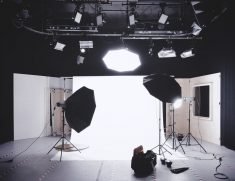Last updated on December 7th, 2023
A light meter measures brightness or how much light is while shooting photography. There is a lot of confusion surrounding what a light meter is capable of doing. This article will introduce how these photography tools can help you take better pictures of your subject matter!

What Is a Light Meter?
A light meter is an instrument that measures how much light there is in a given place or how strongly the brightness of the light varies with time. Light meters come with a sensor, which gives off a response to how light reflects off of surfaces in its field of view.
This information becomes an electrical signal. The signal indicates how brightly the lights are reflecting off of something. There’s not any way for you to “use” a light meter, but they can help you do things like adjusting your camera settings to take better photographs.
Nowadays, digital meters are more common because they’re considerably easier to use! They measure how much light is around you and can tell how fast to set your shutter speed or how wide open the aperture should be.
A common misconception with using a digital meter is that it’s always best to use it following what they suggest. Blindly using a digital meter can lead to dark, overexposed, or an incorrect white balance in photos.

How Do Light Meters Work?
So how do light meters work? How does one determine how bright the area is around you and how to adjust your camera accordingly?
Two parts go into how much exposure it will require:
With reflective metering, there’s the angle of incidence (the incident). Then there’s what kind of lighting situation you’re in (the reflected).
The angle of incidence is how much light there is hitting your subject. Think of it as how bright or dark an environment will be. It will depend on what you’re photographing and where you are around the sun (or any other source!).
If something reflects all this energy back at your meter, it means it’s how bright the subject is (and how much exposure you need to give it).

How To Use a Light Meter for Photography
So how do you use a light meter? You’ll need to look at the scene and then take the reading; that’s how it works! That means an 18% gray card is best because it shows everything as if there were no color. If something has specific colors (like various shades of green), your camera will try to adjust any non-gray tones to look how it should: gray.
So, if you take a reading and your camera doesn’t match what the meter says, then change how bright or dark of an exposure you give it! If there’s too much light in the scene, be sure to shut down one stop (or whatever amount your meter tells you to). If it’s too dark, then open up one stop.
How can you adjust the settings on your camera without a light meter?
If you don’t have a light meter, how can you adjust the settings on your camera to get what you want? That’s where exposure compensation comes in. Using your LCD screen preview, you’ll need to look at how bright or dark the scene is and then use this control as required! In other words, if it has too much light, be sure to use a minus sign (-) and if it has too little light, then choose the plus (+).
Many new cameras have built-in light meters that are pretty accurate. All you have to do is look through your viewfinder, and there will be a bar with + and – showing if your scene is under or overexposed. If your camera doesn’t, then you’ll need to buy a handheld light meter.
Conclusion: All About Light Meters
Understanding how light meters work is an indispensable asset to photographers and videographers. You should know the correct amount of lighting your camera needs to take a photo. That way, you can create more compelling images that don’t get washed out by too much natural sunlight (or turn dark because there’s not enough).
With this guide in hand and some practice with using it in various circumstances, soon you’ll be able to use your camera’s light meter like a pro!


